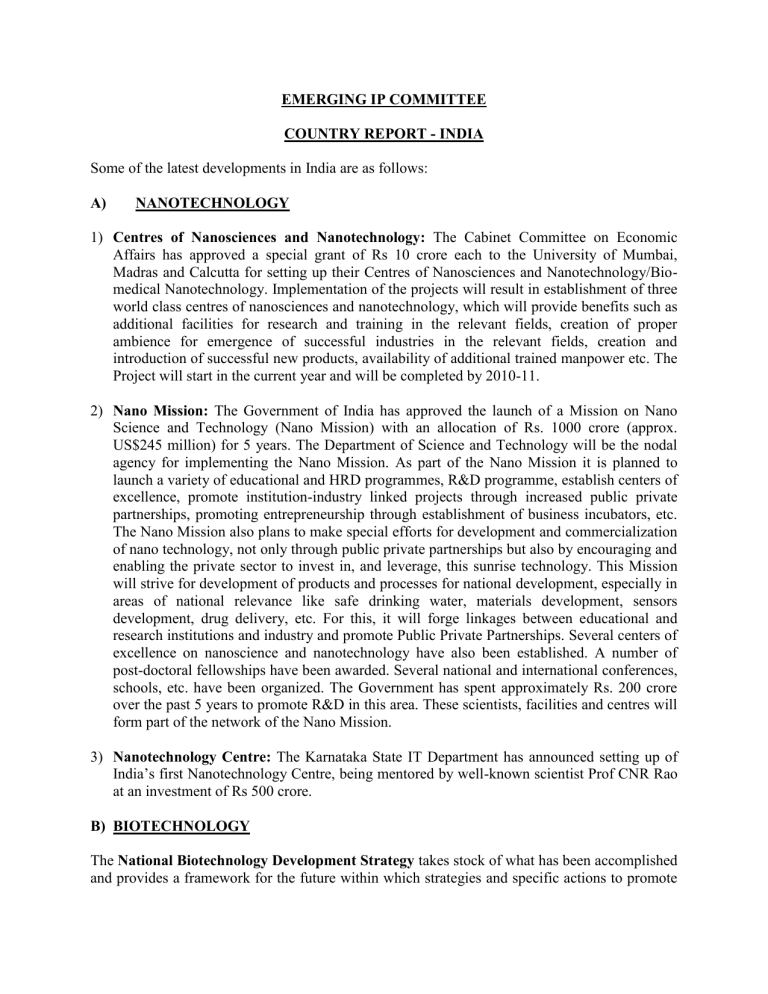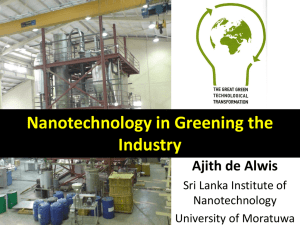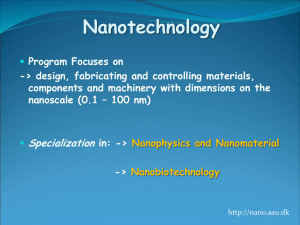Country_Report-India

EMERGING IP COMMITTEE
COUNTRY REPORT - INDIA
Some of the latest developments in India are as follows:
A) NANOTECHNOLOGY
1) Centres of Nanosciences and Nanotechnology: The Cabinet Committee on Economic
Affairs has approved a special grant of Rs 10 crore each to the University of Mumbai,
Madras and Calcutta for setting up their Centres of Nanosciences and Nanotechnology/Biomedical Nanotechnology. Implementation of the projects will result in establishment of three world class centres of nanosciences and nanotechnology, which will provide benefits such as additional facilities for research and training in the relevant fields, creation of proper ambience for emergence of successful industries in the relevant fields, creation and introduction of successful new products, availability of additional trained manpower etc. The
Project will start in the current year and will be completed by 2010-11.
2) Nano Mission: The Government of India has approved the launch of a Mission on Nano
Science and Technology (Nano Mission) with an allocation of Rs. 1000 crore (approx.
US$245 million) for 5 years. The Department of Science and Technology will be the nodal agency for implementing the Nano Mission.
As part of the Nano Mission it is planned to launch a variety of educational and HRD programmes, R&D programme, establish centers of excellence, promote institution-industry linked projects through increased public private partnerships, promoting entrepreneurship through establishment of business incubators, etc.
The Nano Mission also plans to make special efforts for development and commercialization of nano technology, not only through public private partnerships but also by encouraging and enabling the private sector to invest in, and leverage, this sunrise technology. This Mission will strive for development of products and processes for national development, especially in areas of national relevance like safe drinking water, materials development, sensors development, drug delivery, etc. For this, it will forge linkages between educational and research institutions and industry and promote Public Private Partnerships. Several centers of excellence on nanoscience and nanotechnology have also been established. A number of post-doctoral fellowships have been awarded. Several national and international conferences, schools, etc. have been organized. The Government has spent approximately Rs. 200 crore over the past 5 years to promote R&D in this area. These scientists, facilities and centres will form part of the network of the Nano Mission.
3) Nanotechnology Centre: The Karnataka State IT Department has announced setting up of
India’s first Nanotechnology Centre, being mentored by well-known scientist Prof CNR Rao at an investment of Rs 500 crore.
B) BIOTECHNOLOGY
The National Biotechnology Development Strategy takes stock of what has been accomplished and provides a framework for the future within which strategies and specific actions to promote
biotechnology can be taken. It focuses on cross-cutting issues such as human resource development academic and industry interface, infrastructure development, lab and manufacturing, promotion of industry and trade, biotechnology parks and incubators, regulatory mechanisms, public education and awareness building.
C) PROTECTION OF PLANT VARIETY AND FARMER’S RIGHTS AUTHORITY
The
Protection of Plant Variety and Farmer’s Rights Authority
has started accepting applications for Registration of Varieties of 12 notified crop species from May 21, 2007. The
Application for registration has to be submitted to Protection of Plant Variety and Farmer’s
Rights Authority, NASC Complex, DPS Marg, New Delhi.
1.
Farmer’s Rights: Farmer who has bred or developed a new variety or is engaged in the conservation of genetic resources of land races and wild relatives of economic plants and their improvement through selection and preservation shall be entitled for registration and protection.
Farmers shall be entitled to save, use, sow, re-sow, exchange and share or sell his farm produce including seed of a variety protected under this act in the same manner as he was entitled to sell before the act came into force provide that the farmer shall not be entitled to sell branded seeds of a variety protected under this act.
2. Duration of Protection:
(a) For Trees and Vines: 18 years (b) For other crops: 15 years
(c) For extant varieties: 15 years from the date of notification of that variety by the
Government of India under section 5 of the Seeds Act, 1966.
3.
The new variety should be distinct from the other varieties for at least one characteristic.
However, any traditionally cultivated plant variety which has undergone human intervention can be registered.
4.
Pre-requisites: (a) Denomination
(b) Affidavit stating that variety does not contain terminator gene
(c) Complete passport data of parental lines with its geographical location in India
(d) Characteristics with novel, distinctiveness, uniformity and stability
(e) Declaration stating that genetic material used for breeding has been lawfully acquired
(f) Use of genetic material conserved by any tribal or rural family for improvement shall be disclosed
5.
The breeder shall be required to deposit the seeds or propagating material to the
Authority for testing its purity and germination.
6.
The 12 notified crops are: Rice, Bread wheat, Maize, Sorghum, Pearl Millet, Chickpea,
Pigeonpea, Green gram, Black gram, Lentil, Field pea and Kidney Bean.








